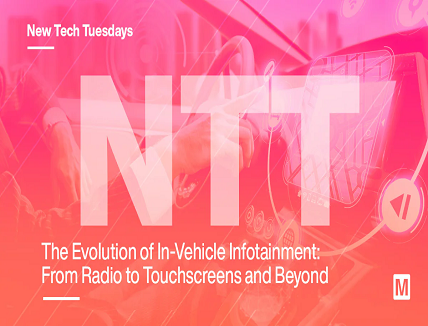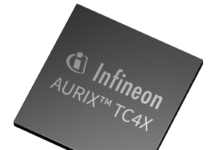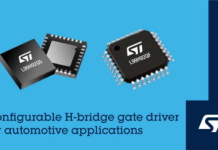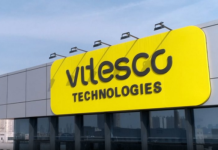
Join Rudy Ramos for a weekly look at all things interesting, new, and noteworthy for design engineers.
Ah, the thrill of driving down the highway with the wind in your hair and the music cranked up to eleven! There’s nothing quite like the feeling of belting out the classic rock hits of the 60s, 70s, and 80s, with the sound of guitar riffs and drumbeats reverberating through your entire body. But times have changed, and today’s vehicles are a far cry from the cars of yesteryear. The days of turn dials and cassette tapes are long gone, replaced by high-tech in-vehicle infotainment systems that offer touchscreens, multi-speakers, and telematics. Sure, we may have lost the tactile pleasure of fiddling with the knobs on the FM radio or the satisfaction of rewinding a cassette tape with a pencil, but we’ve gained so much in terms of sound quality, convenience, and safety. Now, with the touch of a button, we can access thousands of songs and playlists, stream our favorite podcasts or audiobooks, or get real-time traffic updates and directions. We can customize our sound and fine-tune our listening experience to suit our moods or preferences.
In-Vehicle Tech
In-vehicle infotainment and telematics are two technologies that have revolutionized the driving experience in recent years. In-vehicle infotainment systems provide drivers and passengers access to a range of multimedia content, including music, video, and navigation services. Telematics systems, on the other hand, allow vehicles to communicate with other devices and systems, including other vehicles, roadside infrastructure, and cloud-based services. Together, these technologies have transformed the automobile from a simple means of transportation to a fully connected, data-driven platform.
One of the key benefits of in-vehicle infotainment is its ability to provide drivers with real-time information on traffic, weather, and other conditions that may affect their journey. This information can be delivered through a variety of channels, including voice commands, touchscreen displays, and audio alerts. In addition, in-vehicle infotainment systems can provide drivers access to various entertainment options, including streaming music and video services, social media platforms, and even video games. These features can help make long journeys more enjoyable and engaging while reducing driver fatigue and distraction.
The term “telematics” refers to using telecommunications and information technology to transmit data from remote locations. Vehicle telematics systems offer a range of benefits for both drivers and fleet operators. By collecting and analyzing data on vehicle performance, telematics systems can help to identify potential maintenance issues before they become serious problems. In addition, telematics systems can provide real-time tracking of vehicles, enabling fleet managers to optimize routing and scheduling, reduce fuel consumption, and improve overall operational efficiency. Telematics systems can also help to enhance safety by providing real-time alerts and notifications of potential hazards, such as sudden stops or accidents.
Beyond the Touchscreen
As these technologies continue to evolve, designers must address several challenges. One of the main challenges is ensuring that in-vehicle infotainment and telematics systems are secure and reliable. More data transmitted between vehicles and external systems increases the risk of cyber-attacks and other security threats. In addition, there is a need to ensure that these systems are designed with user safety in mind, considering the potential for distraction and other risks.
Another challenge is ensuring that in-vehicle infotainment and telematics systems are accessible and easy to use for all drivers, regardless of their level of technological proficiency. This effort includes designing intuitive, user-friendly systems and providing training and support for drivers less familiar with these technologies.
Despite these challenges, in-vehicle infotainment and telematics systems are expected to continue to play an important role in the future of transportation. With technological advances and greater availability of high-speed connectivity, these systems will likely become even more powerful and sophisticated in the years ahead. As such, it is essential that automakers, technology companies, and other stakeholders work together to ensure that these technologies are developed and deployed in a safe, secure, and user-friendly manner, helping to enhance the driving experience while also improving safety, efficiency, and sustainability.
This week’s New Tech Tuesday features the u-blox JODY-W3 Host-Based Automotive Modules and highlights how these modules support in-vehicle infotainment and telematic capabilities in automotive applications.
u-blox JODY-W3 Host-Based Automotive Modules
The automotive industry has seen tremendous growth and innovation over the years, with cutting-edge technologies constantly pushing the boundaries of what is possible. One such technology is the JODY-W3 Host-Based Automotive Modules from u-blox. These advanced modules offer exceptional performance and reliability for connected cars and autonomous vehicles. The JODY-W3 Host-Based Automotive Modules are designed to provide seamless connectivity for a range of applications, including infotainment systems, navigation, and telematics. They support a wide range of wireless protocols, including LTE, GNSS, dual-mode Bluetooth® 5.3, and Wi-Fi 6®, and offer unparalleled flexibility and scalability for OEMs. Additionally, the u-blox JODY-W3 modules are equipped with advanced features such as eCall, which enables automatic emergency calling in the event of an accident, and vehicle-to-everything (V2X), which allows vehicle-to-vehicle (V2V) and vehicle-to-infrastructure (V2I) communication for enhanced safety and efficiency on the road. With their compact size, low power consumption, and robust design, the u-blox JODY-W3 modules are an ideal solution for automotive applications that require high performance, reliability, and security. Let the u-blox JODY-W3 modules help you build the next generation of connected cars with advanced navigation and telematic capabilities.
Tuesday’s Takeaway
While the days of FM radio turn dials and cassette tapes are long gone, the thrill of driving down the highway is still there, except that we now have access to all kinds of high-tech audio systems and streaming services. In-vehicle infotainment and telematics are two technologies that have transformed the driving experience, providing drivers with a range of features and services that enhance safety, convenience, and entertainment. As these technologies continue to evolve, we can expect to see even more advanced features and functionality that will further enhance the driving experience and pave the way for the future of transportation. With the u-blox JODY-W3 modules, automotive design engineers have the perfect solution to build the next generation of connected cars, further advancing in-vehicle infotainment and telematics systems.


















